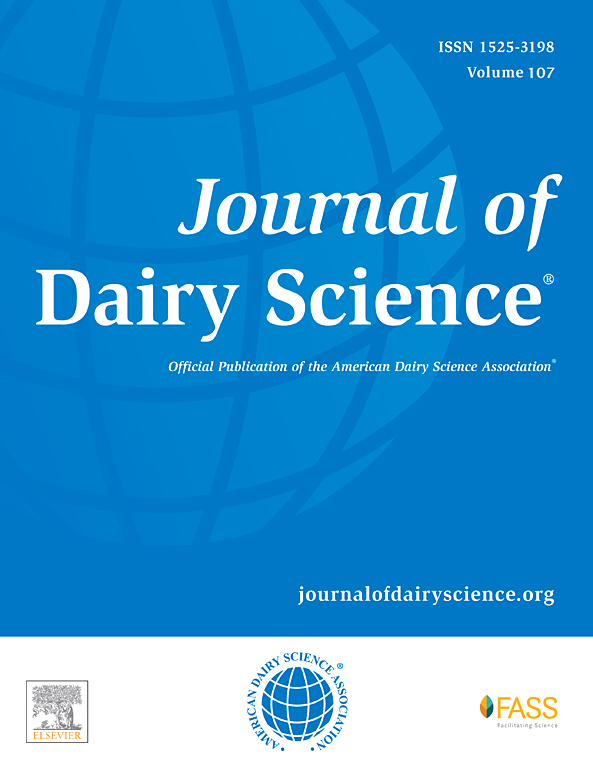选择性干牛疗法:预防和治疗乳内感染的临床实验。
IF 3.7
1区 农林科学
Q1 AGRICULTURE, DAIRY & ANIMAL SCIENCE
引用次数: 0
摘要
泌乳末期的乳房内抗生素干牛疗法(DCT)是管理和控制牛乳腺炎的关键措施之一。目前,畜牧生产面临着减少抗生素消耗量的压力,因此需要避免在干奶期对所有奶牛用药,而只对受感染的奶牛进行治疗。该研究的目的是评估在干奶期治疗过 DCT 和未治疗过 DCT 的牛群之间的 IMI 治愈风险、新的 IMI 风险和产后 IMI 风险。样本共计269头奶牛,来自2019年至2021年期间进入干燥期的12个芬兰全自动机器人挤奶系统牧场。符合研究条件的奶牛最终DHI测试日SCC≥100,000个细胞/毫升,且无乳腺炎临床症状。根据奇数或偶数识别号码,SCC 在 100,000 cells/mL 到 250,000 cells/mL 之间的奶牛被依次分配到在干奶时接受 DCT(DCT100-250)或不接受治疗(NoDCT100-250)。所有 SCC > 250,000 cells/mL 的奶牛均接受 DCT 治疗(DCT > 250)。所有牛舍均未使用乳头密封剂。牧场主在干奶前 0 至 4 d 和产犊后 0 至 4 d 采集无菌四分之一乳样品,进行微生物实时定量 PCR (qPCR) 分析。统计模型的结果是犊牛产后 0 至 4 d 挤奶时四分之一奶出现 IMI 的几率。统计工具是一个广义线性混合效应模型,该模型具有 logit 连接功能和 2 级随机截距,奶牛嵌套在牛群中。干奶时的季度级IMI流行率为:NoDCT100-250 17.6% (45/256),DCT100-250 22.2% (83/374),DCT > 250 32.0% (132/413)。新陈代谢时的季度级 IMI 患病率为:NoDCT100-250,36.2%(84/232);DCT100-250,13.6%(50/369);DCT > 250,11.6%(46/397)。与 DCT100-250 组相比,NoDCT100-250 组中未经治疗的宿舍在干燥期内未能治愈的风险高出 1.1 倍(未经调整的 RR 为 1.10,95% CI 为 0.94-1.28),与 DCT > 250 组相比,未经治疗的宿舍在干燥期内未能治愈的风险高出 1.2 倍(未经调整的 RR 为 1.15,95% CI 为 1.00-1.33)。在干燥期内,NoDCT100-250 组中未接受治疗的宿舍发生新 IMI 的风险比 DCT100-250 组中接受治疗的宿舍高 1.5 倍(未经调整的 RR 为 1.48,95% CI 为 1.35-1.63),比 DCT > 250 组中接受治疗的宿舍高 1.4 倍(未经调整的 RR 为 1.35,95% CI 为 1.23-1.49)。新发 IMI 的主要原因是 NAS,其次是痢疾链球菌。NoDCT100-250组中的四分位在新生时发生IMI的几率是DCT100-250组的6.6倍(95% CI 3.52-12.21)。根据我们在该实验框架内的研究结果,选择性地对干奶时SCC在10万至25万个细胞/毫升之间的奶牛进行DCT处理,结果表明,尽管干奶期各组的治愈风险很高,但未接受处理的牛群在干奶期感染新的IMI的风险高于接受处理的牛群,这凸显了DCT在降低IMI风险方面的有效性。不过,并不建议预防性使用抗生素,有些国家甚至禁止使用抗生素。本文章由计算机程序翻译,如有差异,请以英文原文为准。
Selective dry cow therapy: Clinical field trial on prevention and cure of intramammary infections
Intramammary antibiotic dry cow therapy (DCT) at the end of lactation is a key measure in the management and control of bovine mastitis. Currently, livestock production is under pressure to reduce antibiotic consumption, emphasizing the need to avoid medicating all cows at dry-off, and instead treat only infected cows. The study objective was to evaluate IMI cure risk, new IMI risk, and postcalving IMI risk between DCT-treated and untreated quarters over the dry period. The sample totaled 269 cows from 12 Finnish automatic milking system herds entering the dry period between 2019 and 2021. Cows eligible for the study had a final DHI test-day SCC ≥100,000 cells/mL and had no clinical signs of mastitis. Based on odd or even identification numbers, cows with an SCC between 100,000 and 250,000 cells/mL were sequentially assigned to either receive DCT at dry-off (DCT100–250) or remain untreated (NoDCT100–250). All cows with an SCC >250,000 cells/mL received DCT (DCT>250). No quarters received teat sealants. Farmers collected aseptic quarter milk samples for microbiological quantitative real-time PCR analysis 0 to 4 d before dry-off and 0 to 4 d after calving. The outcome of the statistical model was the odds of a quarter having an IMI at freshening 0 to 4 d after calving. The statistical tool was a generalized linear mixed-effects model with logit link function and 2-level random intercepts, cows nested within herds. Quarter-level IMI prevalence at dry-off was 17.6% (45/256) for NoDCT100–250, 22.2% (83/374) for DCT100–250, and 32.0% (132/413) for DCT>250. Quarter-level IMI prevalence at freshening was 36.2% (84/232) for NoDCT100–250, 13.6% (50/369) for DCT100–250, and 11.6% (46/397) for DCT>250. The untreated quarters in the NoDCT100–250 group had a 1.1 times higher risk of failing to cure over the dry period than the treated quarters in the DCT100–250 group (unadjusted risk ratio [RR] 1.10, 95% CI 0.94–1.28) and a 1.2 times higher risk than the treated quarters in the DCT>250 group (unadjusted RR 1.15, 95% CI 1.00–1.33). The untreated quarters in the NoDCT100–250 group had a 1.5 times higher risk of having a new IMI over the dry period than did the treated quarters in the DCT100–250 group (unadjusted RR 1.48, 95% CI 1.35–1.63) and a 1.4 times higher risk than the treated quarters in the DCT>250 group (unadjusted RR 1.35, 95% CI 1.23–1.49). The principal cause of new IMI was NAS, followed by Streptococcus dysgalactiae. Quarters in the NoDCT100–250 group had 6.6 times higher odds for having an IMI at freshening than did quarters in the DCT100–250 group (95% CI 3.52–12.21). According to our findings within the framework of this experiment, selectively DCT-treated cows with an SCC between 100,000 and 250,000 cells/mL at dry-off demonstrated that, although the group-specific cure risks over the dry period were high, untreated quarters had a higher risk of acquiring a new IMI over the dry period than did treated quarters, highlighting the effectiveness of DCT in reducing IMI risks. The prophylactic use of antibiotics, however, is not recommended, and in some countries is even prohibited.
求助全文
通过发布文献求助,成功后即可免费获取论文全文。
去求助
来源期刊

Journal of Dairy Science
农林科学-奶制品与动物科学
CiteScore
7.90
自引率
17.10%
发文量
784
审稿时长
4.2 months
期刊介绍:
The official journal of the American Dairy Science Association®, Journal of Dairy Science® (JDS) is the leading peer-reviewed general dairy research journal in the world. JDS readers represent education, industry, and government agencies in more than 70 countries with interests in biochemistry, breeding, economics, engineering, environment, food science, genetics, microbiology, nutrition, pathology, physiology, processing, public health, quality assurance, and sanitation.
 求助内容:
求助内容: 应助结果提醒方式:
应助结果提醒方式:


